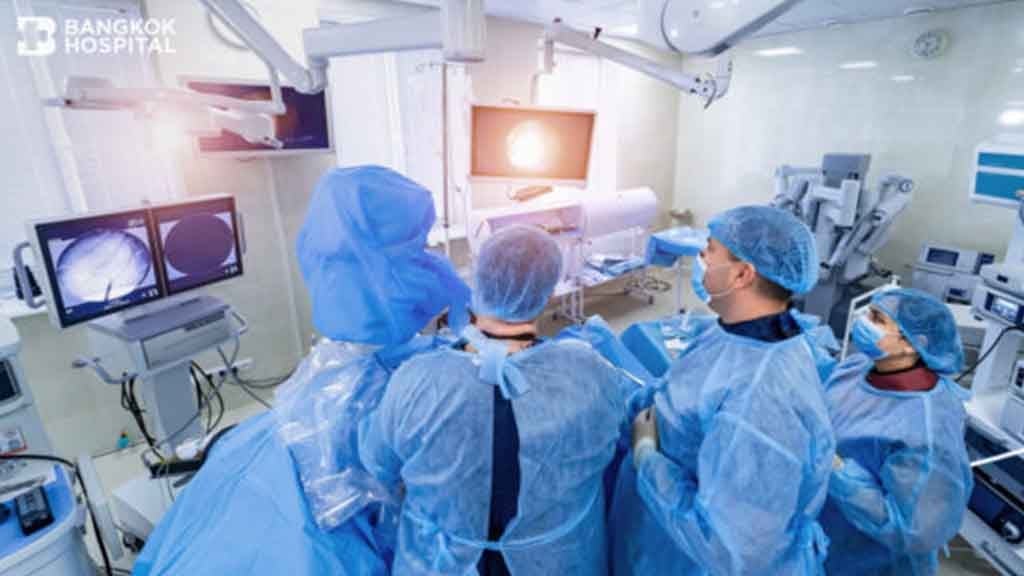Video Assisted Thoracic Surgery Lobectomy – The New Surgical Technique For Lung Cancer
Lung cancer is the leading cause of cancer related deaths in Thailand. Lung cancer typically does not cause signs and symptoms in its earliest stages. Signs and symptoms of lung cancer typically occur only when the disease is advanced. Patients usually find out that they have lung cancer when the disease is spreading to other organs.
With technological advancement, there are new investigations for lung cancer; Low Dose Computed Tomography (Low Dose CT), Navigational Bronchoscopy, and Positron Emission Tomography (PET/CT). These tools can help find lung cancer early (stage 1-2). Early stage lung cancer can be cured by video assisted thoracic surgery – lobectomy (VATS Lobectomy). This surgical technique can also be used in patients with recurrent pneumothorax, thymoma, esophageal cancer, and malignant pleural or pericardial effusion.
Lung cancer treatment
There are 3 main treatment options: surgery, chemotherapy, and radiotherapy. The treatment decision depends on the stage of the disease.
-
Stage 1 (The cancer is 3 centimeters or smaller and has not spread to lymph nodes or other organs): The treatment is surgical removal of the tumor. Chemotherapy and radiotherapy are not necessary. If the disease is in stage 1a (tumor is less than 1 centimeter), 5 year survival rate is around 92%. Currently, there is a lung cancer screening program that uses low dose CT-Scan. Participation in a lung cancer screening program increases survival chances when lung cancer is detected because the cancer is most often detected early. Early cancer detection increases treatment options and chances for cure. The screening is recommended for individuals who have a 30 pack-year smoking history or have a family history of lung cancer.
-
Stage 2 (The cancer is larger than 3 centimeters or has spread to lymph nodes, and does not affect the bronchus): The treatment options are surgery with or without chemotherapy.
-
Stage 3 (The cancer has spread into other mediastinal organs or to the bronchus): The treatment options are chemotherapy or immunotherapy with surgery and radiotherapy.
-
Stage 4 (The cancer has spread outside the chest to a lymph node or to an organ, or there is fluid around the lungs or the heart that contains cancer cells): The treatment options are chemotherapy or immunotherapy with or without surgery to control the symptoms.

Video-assisted thoracic surgery (VATS)
For those with early stage lung cancer (stage 1 or 2), the treatment is lobectomy – surgical removal of a large section of lung or sublobar resection – surgical removal of small segment of lung. This can be done by thoracoscopy or video-assisted thoracic surgery (VATS). Traditionally, lobectomy has been performed during thoracotomy surgery. During thoracotomy surgery, an incision is made on the side of the chest between the ribs. The ribs are then spread apart so the surgeon can see into the chest cavity and remove the tumor or affected tissue. The traditional open-chest approach typically requires five to seven days of recovery in the hospital, with an extended recovery time at home. With VATS technique, the recovery time is only 2-3 days. This new technique provides several important benefits, which include: faster recovery and return to normal activities, shorter hospital stay, less pain and scarring, and minimal blood loss.
With technological advancements, the camera that will be inserted through a small incision is only 5 millimeter in size. Specially designed instruments may also be inserted through one or two more ports. The number of surgical wounds depends on the characteristic of the tumor and the surgeon’s expertise.
The surgeon might remove a section or whole lobe of lung depending on the size and location of the tumor, patient’s age, and lung function.
Thoracotomy
For patients with stage 3 lung cancer, the disease has spread to other mediastinal organs or the patients need surgery after receiving chemotherapy. Thoracotomy is a more suitable treatment option as it allows surgeon to access other organs during the surgery. In addition, pneumonectomy (surgical removal of one of the lungs) or sleeve resection (surgery to remove a tumor in a lobe of the lung and a part of the main bronchus) might be performed to remove the cancer completely. However, these procedures can also be done by robotic assisted thoracic surgery (RATS). This allows surgeons to perform many types of complex procedures with more precision, flexibility and control than it is possible with conventional techniques.
.jpg)
Reference : Dr. Padungkiat Tangpiroontham, a cardiothoracic surgeon specialized in minimally invasive thoracic surgery.
-
IASLC staging system (8th edition) 2016
-
NCCN 2017
-
Peterson et al, Ann Thorac Surgery 2007
-
Nicastri et al, JTCS 2008
-
Int 0139, Lancet 2009







